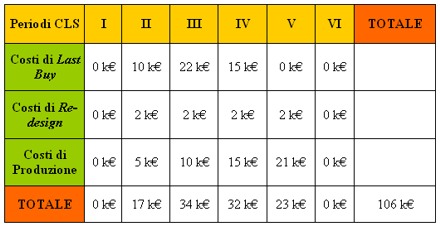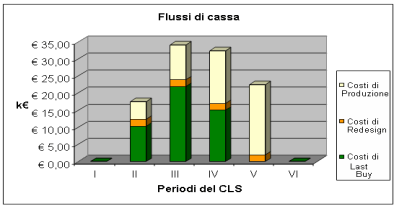Chapter 7 - a model developed in a company of the production field and maintenance radar.
The percentage of LRU that will come resolved with Redesign ( ) and the rate members classifies you of type B and C who will come resolved with the Last Buy comes supplied from relative data you to a previous program.
) and the rate members classifies you of type B and C who will come resolved with the Last Buy comes supplied from relative data you to a previous program.
The CLS in 6 periods is divided: the first format from 4 years, the successes to you from 3 years, following logic of the contract, that is the possibility to renew it after the first quatto years, every three years.
For every period I consider:
- Costs of last buy;
- Costs of redisign;
- Production costs of the not repairable cards.
They do not come considers neither costs of maintenance to supply, neither costs you of monitoring. For the calculation of the cost of resolution according to the method Design/Production, it comes considered an obsolescence rate anniversary of the LRU, without to go to consider the members who cause such problem.
It comes calculated, therefore, an obsolescence rate equal anniversary to

The terms of the expression are:
 = Percentage of LRU resolved with the method Design/Production;
= Percentage of LRU resolved with the method Design/Production;
 = annual Rate obsolete LRU;
= annual Rate obsolete LRU;
ANNI = Years of the CLS.
Such rate  comes considered constant in the years.
comes considered constant in the years.
Other data of input that they come used in this calculation are: n° LRU = Population of present LRU make on a system;
n° RIP = Number of LRU make to repair in a year;
cRIP = Cost in order to repair one LRU make;
cPROD = Cost in order to produce one LRU make;
cRD = Cost in order to redesign one LRU make.
The costs of redesign come calculate to you in the following way:

RDj cost = Costs of redesign in the period j-esimo;
n = Number of years that elapse from the first year of the CLS to the last one of the period j-esimo.
The production costs, or more properly the difference between the costs of new productions and those of repair, come calculate to you in the following way:

Produzionej cost = Production cost in the period j-esimo;
Nj = Number of years of the period j-esimo.
It is assumed moreover that, in the first one and the last period, it does not come made some participation of redesign: in the first one because one supposes that us of it is not need, in the last one because contract CLS turns to the term and it does not convene to take part on phenomena that will have repercussions when the system is not of competence of the company.
As far as the calculation of the resolution cost second the action of Last Buy, considers a rate regarding obsolescence members who, once recognized obsolete they come classifies to you like category B and C.
For classified member of type B one agrees that a possible alternative exists, but that it introduces parameters works them leggermente different; the compatibilities, therefore, must be verified on the LRU of belongings.
For classified member of type C one agrees that it has not been found some alternative compatible.
In both cases therefore it is gone to make a Last Buy of the member originates them in order to avoid the redesign.
This reasoning is consequent to the approach of followed reactive type in SELEX-SI: in the moment in which a member it comes classified like B or C, the alternative of the Last Buy it comes pursued, but with risk to find members to a remarkablly increased price.
Returning to the calculation of the costs of Last Buy, the data of input are: Mat = Percentage of the cost of the system due to the cost of the materials;
cSIST = Cost of a system;
p = Rate members classifies you of type B and C.
It comes calculated
cMaterial = cSIST * Mat. cMaterial = Cost of the materials that constitute a system.
CostoLB = Material * p
This value, comes then chargeed, like purchase, to fifth, eighth and the eleventh year.
As last thing assumes that in the first years I have members to warehouse in order to make forehead enough the first necessities.
Later on I suppose that the members that I buy in the periods center them of the CLS allow me to support the production also in the last periods.
It turns out to you are brought back in the successive table. 
Table 7.5: It turns out to you model SELEX-SI.
Such values are diagrammati in the following histogram.

Figure 7.17: Cash flows model SELEX-SI.
![]() ) and the rate members classifies you of type B and C who will come resolved with the Last Buy comes supplied from relative data you to a previous program.
) and the rate members classifies you of type B and C who will come resolved with the Last Buy comes supplied from relative data you to a previous program.![]() = Percentage of LRU resolved with the method Design/Production;
= Percentage of LRU resolved with the method Design/Production;![]() = annual Rate obsolete LRU;
= annual Rate obsolete LRU;
